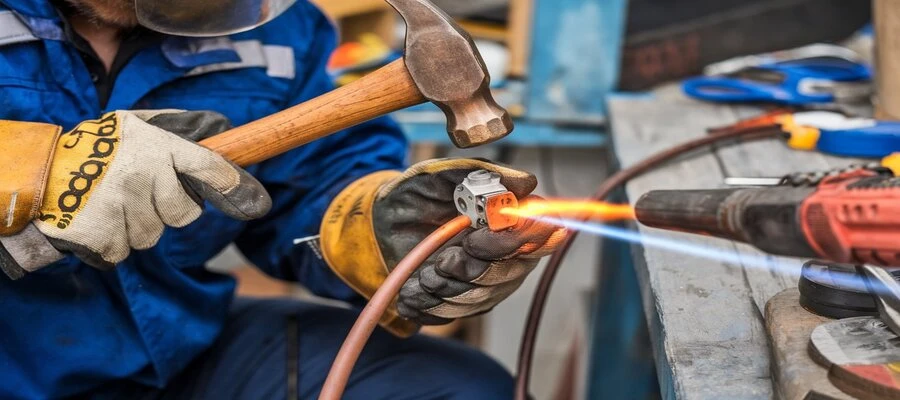
Thermal management is crucial for maintaining the efficiency and safety of electrical systems by managing heat generation and dissipation, preventing overheating, and ensuring reliable performance with proper cable lug selection and installation.
What Is Thermal Management? Heat Management with Cable Lugs
Thermal management is essential for maintaining the efficiency and safety of electrical systems. It involves controlling heat generation and dissipation within electrical circuits to prevent overheating, which can cause equipment failure or fire hazards. Cable lugs play a crucial role in thermal management by ensuring effective heat transfer and maintaining secure electrical connections. Selecting the right cable lugs, such as battery cable lugs, and implementing proper installation techniques are paramount for optimal heat management. Understanding the significance of heat management in electrical systems emphasizes the critical role cable lugging plays in maintaining system reliability and longevity. Proper application of these components helps in reducing thermal bottlenecks and ensuring efficient energy distribution throughout your electrical systems.
How to Ensure Heat Management with Proper Cable Lug Selection
Proper cable lug selection is vital for efficient heat management. Choosing the right lug size and material can greatly influence the heat dissipation capabilities of a connection:
1. Material Matters: Cable lugs made of high-conductivity materials like copper are excellent for heat transfer and reduce thermal resistance.
2. Current Capacity: The lug's size must match the current-carrying capacity of the cable to avoid overheating and ensure efficient performance.
Understanding these factors helps in selecting the appropriate lug, thereby enhancing the overall thermal management of your electrical systems. Additionally, considering the specific application and requirements of cable with lugs can prevent thermal bottlenecks and ensure consistent performance. Selecting high-quality materials and appropriate sizes ensures that the system runs smoothly without any heat-related issues, thus extending the lifespan of the system components.
Choosing Cable Lugs Based on Current Capacity
Selecting cable lugs based on their current capacity is paramount for preventing thermal issues. An improperly sized lug can overheat, leading to potential system failures and costly repairs. Cable lugs should also accommodate future expansions to maintain system integrity over time.
Cable Lug Types That Maximize Heat Distribution
Different types of cable lugs offer varying levels of heat distribution. Welding cable lugs, for example, are designed to endure high temperatures, ensuring better thermal management. Knowing the specific application can help in choosing a cable lug that maximizes heat distribution.
The Impact of Cable Lug Design on Thermal Management
Cable lug design significantly impacts thermal management. A well-designed lug not only enhances electrical connectivity but also efficiently dissipates heat. The overall shape, size, and thickness of the lug determine how well it can handle thermal loads:
1. Shape: Lug designs that maximize surface contact with cables improve heat distribution.
2. Thickness: Thicker lugs made from high-conductivity materials like cable lug copper manage thermal loads better by reducing resistance.
These elements work together to ensure your electrical connections remain cool and efficient under load. Proper design considerations are pivotal for integrating efficient heat management in various cable lugging applications. The right design can drastically reduce overheating issues and enhance the overall functionality of your electrical infrastructure.
The Role of Thickness and Shape in Heat Management
The thickness and shape of a cable lug are critical for optimal heat management. Thicker and well-shaped lugs distribute heat more evenly, reducing hotspots and enhancing the efficiency of your electrical system. Investing in appropriately designed lugs ensures long-term thermal efficiency.
Tips for Enhancing Thermal Efficiency During Cable Lug Installation
Proper installation techniques can further enhance thermal efficiency:
1. Crimping: Use the correct crimping tools to secure the lug onto the cable. Inadequate crimping can lead to poor contact and heat buildup.
2. Insulation: Ensure all connections are insulated properly to avoid heat loss and prevent potential short circuits.
3. Periodic Checks: Regularly inspect connections to ensure there are no signs of overheating or corrosion, which can affect heat management.
By following these tips, you ensure the longevity and reliability of your electrical system. Employing meticulous installation practices for cable with lugs significantly contributes to superior thermal management. Keeping a keen eye on the installation process and following manufacturer's guidelines can prevent most heat-related issues.
Maintenance and Inspection Tips for Thermal Management in Cable Connections
Regular maintenance and inspection are crucial for effective thermal management:
1. Visual Inspection: Regular visual inspections can help identify wear and tear, corrosion, or other damage that may affect heat management.
2. Thermal Imaging: Use thermal imaging cameras to detect hotspots and ensure even heat distribution.
3. Tightening Connections: Over time, connections can loosen, affecting thermal efficiency. Regularly tighten connections to maintain optimal performance.
Incorporating these practices into your maintenance routine enhances the reliability of your electrical system.